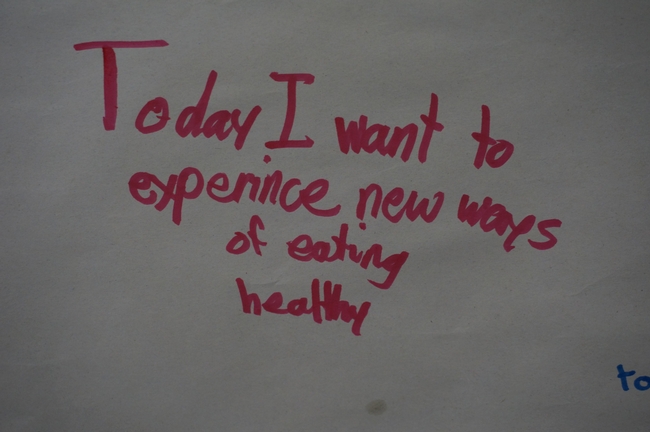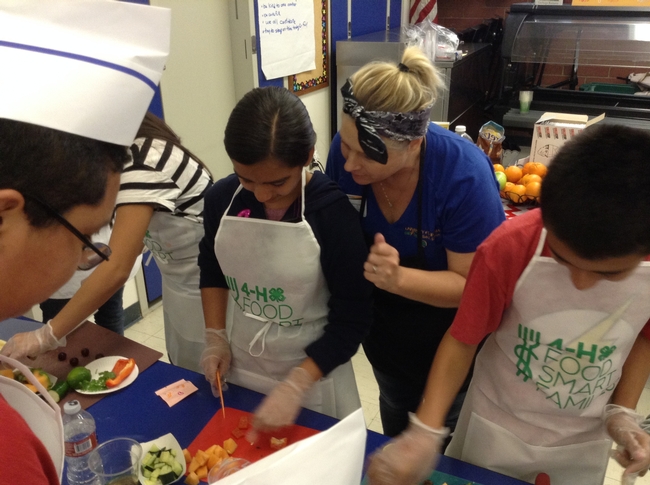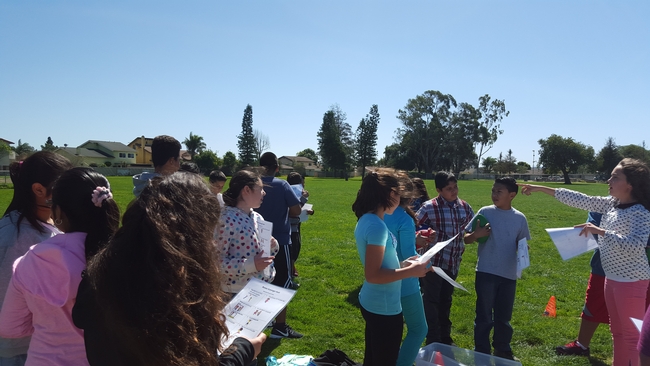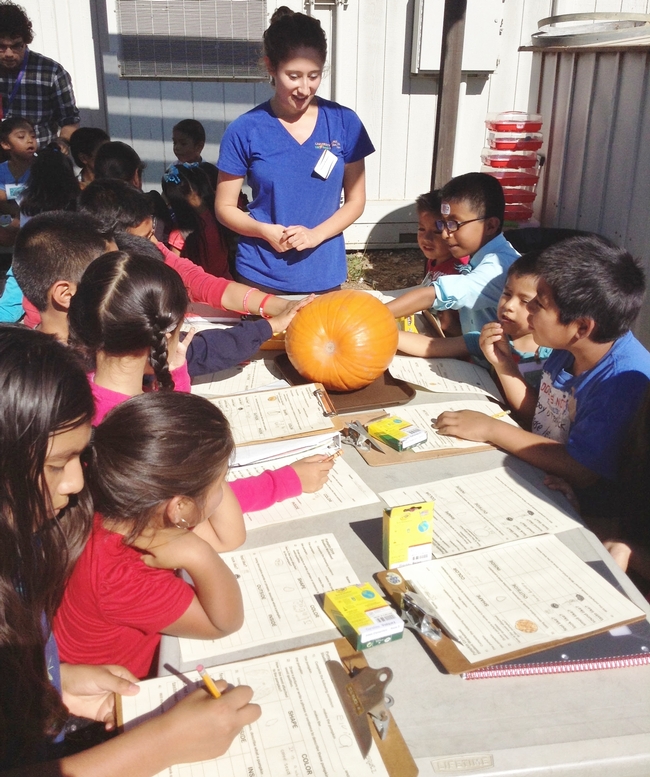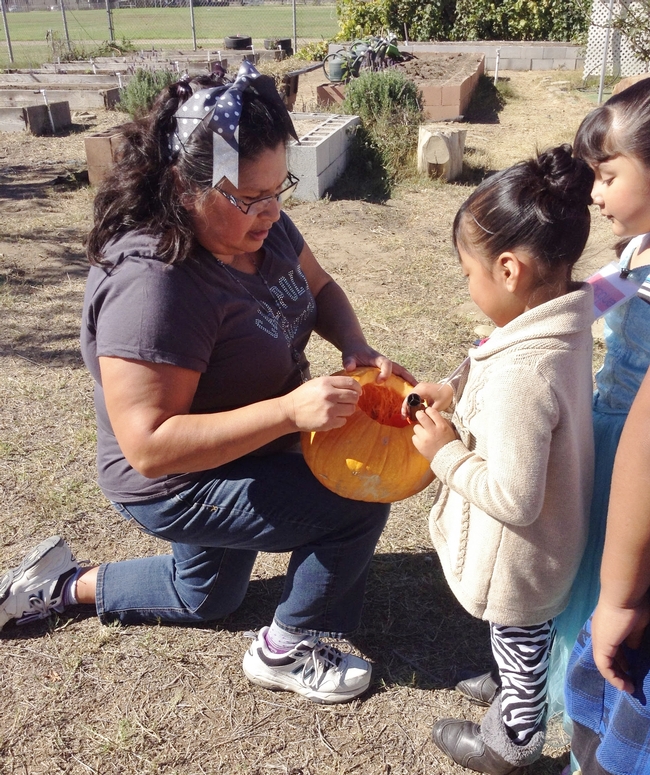Posts Tagged: Santa Barbara
Inspiring youth leaders to cultivate health
What are sixth-graders interested in these days? “Cooking!” “Growing food!” “Learning how to be healthier.” “Exercising.” “Meeting new friends!” These enthusiastic answers came from sixth-grade student leaders in Santa Maria, Calif., when asked by educators from the UC Cooperative Extension Youth, Families and Communities program in San Luis Obispo and Santa Barbara counties.
Through an integrated youth-focused healthy living project, called Food Smart Families, funded by National 4-H, the UC ANR 4-H Youth Development Program, and the UC CalFresh Nutrition Education program, 32 fourth- through sixth-grade student leaders were brought together from three schools in Santa Maria, Calif., for a full-day educational retreat that focused on engaging youth to explore their healthy lifestyle interests and see themselves as leaders.
Throughout the day, student leaders experienced physical activity games, learned cooking skills, participated in garden-based learning, and developed their presentation skills. They focused on skill development, as well as transference so that the student leaders could take these activities into their own schools to encourage and teach their peers. For example, the fun physical activity breaks that were incorporated throughout the day modeled games where no one is “out” or excluded, while moving enough to get heart rates up.
After the retreat, the student leaders brought these activities to their own schools, leading their peers in the games during lunch and recess breaks. During the retreat, the student leaders also got to practice knife safety skills while chopping produce to prepare their own veggie pita pockets and fruit salads. With these skills, the student leaders offered food demonstrations and nutrition lessons to their peers during the following weeks.
In the garden, student leaders learned the basics of growing food and how to lead a garden lesson. Students discussed garden tools and how to use them safely, then planted their own seeds to take home. The garden session ended with a gleaning of the school citrus orchard where students laughed and enjoyed the fresh air and fresh fruits growing around them. In their own school gardens, the student leaders have offered lessons and tastings to their peers.
The retreat culminated with youth presentations. The student leaders worked in teams with students from different schools to generate ideas and artwork for the Student Nutrition Advisory Council (SNAC) logo and t-shirt design. They presented their concepts to the larger group, practicing their presentation skills. The student leaders voted on the designs and a winner was selected to be featured on a t-shirt for SNAC leaders at each of the three schools. The students leaders proudly wear their shirts as they lead healthy living education, advocacy and engagement activities.
By the end of the retreat, the student leaders were excited to take the information and skills back to their schools and start leading. Students shared their plans to help other students be more active during recess, be healthy, and help other kids be healthier too.
“This was the best day I have ever had,” said one of the students.
Since the retreat, the student-led initiatives have been numerous and continually evolving. The sixth-graders have encouraged and trained younger students to become their successors as they move onto junior high. Several students co-authored and starred in a video production called “Get to Know Your Salad Bar.” With educator encouragement, the student leaders developed a script to motivate their peers to try out the salad bar by mixing fruit into their salad to make it sweet or putting lettuce and tomato on your hamburger to make it juicy and crunchy. Beyond leading in their own schools, the student leaders have been working to help their entire community. Many of the student leaders helped organize and conduct game-style nutrition activities at a local food pantry distribution to teach families about shopping for healthy foods on a limited budget. Other student leaders provided education and training to students at neighboring schools, encouraging them to become leaders as well.
Through the efforts of the Food Smart Families program, the Youth, Families, & Communities program in San Luis Obispo & Santa Barbara counties merged the strengths of the UC CalFresh Nutrition Education program and the UC ANR 4-H Youth Development program to provide new opportunities and experiences for students in this community. With interested and caring adults, these student leaders learned to share their passions for cooking, gardening, and healthy lifestyle with their peers at school and others in their community. The rewards for the school, community and adult allies continue to expand as these inspired student leaders, with strong mentorship and support, take on some of the biggest challenges facing our society and world.
Planting the seeds for garden-based education
The UC CalFresh Nutrition Education Program in Santa Barbara County (UC CalFresh) is planting new ideas and possibilities to increase teacher use of school gardens.
Each school day, teachers must carefully plan and account for their instructional minutes. For each grade level has specific time recommendations for math and English language arts, so teachers often feel they do not have the time to include extra activities in their already packed schedules. When UC CalFresh gave a brief survey to teachers a Santa Maria school last year, teachers identified the following barriers to using their school garden for instruction:
- Lack of instructional time or preparation time
- Lack of curriculum and learning activities
- Too many students to manage in the outdoor setting
These concerns reflected comments that UC CalFresh nutrition educators frequently heard from teachers who were invited to bring their students to the school garden.
Taking these concerns into consideration, UC CalFresh developed innovative strategies to meet the needs of school teachers, showing how instructional minutes in the garden don't have to be “extra” and can include hands-on learning for English language arts and math, with a focus on nutrition. The strategies include:
- Clearly aligning garden-based nutrition education with common core lessons
- Providing garden-based curriculum and materials for learning activities in the garden
- Hosting Garden Open House Days, during which teachers can bring their students to the garden when UC CalFresh Educators are present to increase educator-to-student ratios.
To meet the needs of partnering teachers, UC CalFresh educators developed “No-Prep Nutrition Education Kits,” enabling teachers to teach common core-aligned nutrition education lessons without having to use prep time to make copies or create materials of their own. This year, based on the survey data, UC CalFresh expanded the No-Prep Nutrition Education Kits to include lessons that could be taught in the garden.
The first No-Prep Garden-Based Nutrition Education Kit was piloted in October and featured pumpkins. The No-Prep Kit became fondly known as the Pumpkin Kit. The Pumpkin Kit encouraged teachers to take the lesson out to the garden, increasing students' physical activity time while providing opportunities for students to practice common core skills. The kit focuses on nutrition and cooking while reinforcing math, science and language arts. The kit includes books, worksheets, an oven, and several different pumpkins for measuring, cooking, estimating, and tasting. This kit requires no teacher prep time, is adaptable to any primary grade level, and is an easy introduction to garden-based lesson delivery.
During a Garden Open House Day hosted by UC CalFresh in October, kindergarten students and their fifth-grade buddies came out to the garden. The fifth-grade buddies worked with the kindergarten students to use observation skills (five senses), learn adjectives, and draw the pumpkin life cycle. The older buddies gained teaching and language arts skills while working with their little buddies in the garden. Students got to dissect the pumpkins in teams and used the seeds for counting. Each kindergartener took 20 seeds home to practice counting with their parents, which also served as a budding connection for students' families and the school garden.
"If we had something like this every month, we would be able to go out into the garden more and maybe we could get more teachers to come. This is what we need, curriculum that can be used in the garden," said kindergarten teacher Mrs. Joaquin.
Moving forward, UC CalFresh is piloting bimonthly No-Prep Kits for garden-based lessons, featuring the USDA's DigIn! curriculum, as well as other UC curricula. Teachers can teach with the kits on their own in the garden or come during UC CalFresh hosted Garden Open House Days for extra educator support. By easing teachers' paths into the garden, students get to spend time outdoors, engage in physical activity, and participate in learning that reinforces their science, English language arts and math skill development.
“The program has been awesome," said one fourth-grade teacher. "[UC CalFresh] incorporated math, science, social studies into lessons. Students were excited and engaged. Many tried new vegetables they'd never had before and liked them! Kids learned responsibility and pride in designing, choosing plants, maintaining and harvesting in school garden.”
For more on UC CalFresh of San Luis Obispo and Santa Barbara counties see the Facebook page at facebook.com/uccalfreshslosb
UC CalFresh nutrition education is offered in schools jointly by UC Agriculture and Natural Resources and USDA.


